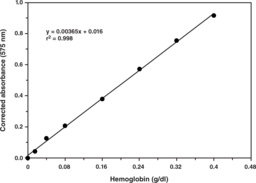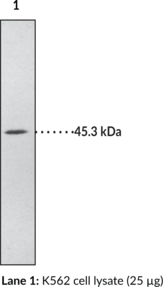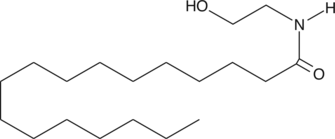Cayman
Showing 23551–23700 of 45550 results
-
Hederasaponin B is a triterpene saponin that has been found in H. helix and has antiviral and antioxidant activities.{59073,60035} It inhibits the cytopathic effect induced by the enterovirus 71 (EV71) genotypes C3 and C4a (EC50s = 24.77 and 41.77 µg/ml, respectively), as well as reduces expression of the viral structural capsid protein VP2, in Vero cells.{59073} Hederasaponin B (100, 150, and 200 µg/ml) inhibits superoxide generation in human neutrophils.{60035}
Brand:CaymanSKU:30641 - 1 mgAvailable on backorder
Hederasaponin B is a triterpene saponin that has been found in H. helix and has antiviral and antioxidant activities.{59073,60035} It inhibits the cytopathic effect induced by the enterovirus 71 (EV71) genotypes C3 and C4a (EC50s = 24.77 and 41.77 µg/ml, respectively), as well as reduces expression of the viral structural capsid protein VP2, in Vero cells.{59073} Hederasaponin B (100, 150, and 200 µg/ml) inhibits superoxide generation in human neutrophils.{60035}
Brand:CaymanSKU:30641 - 10 mgAvailable on backorder
Hederasaponin B is a triterpene saponin that has been found in H. helix and has antiviral and antioxidant activities.{59073,60035} It inhibits the cytopathic effect induced by the enterovirus 71 (EV71) genotypes C3 and C4a (EC50s = 24.77 and 41.77 µg/ml, respectively), as well as reduces expression of the viral structural capsid protein VP2, in Vero cells.{59073} Hederasaponin B (100, 150, and 200 µg/ml) inhibits superoxide generation in human neutrophils.{60035}
Brand:CaymanSKU:30641 - 25 mgAvailable on backorder
Hederasaponin B is a triterpene saponin that has been found in H. helix and has antiviral and antioxidant activities.{59073,60035} It inhibits the cytopathic effect induced by the enterovirus 71 (EV71) genotypes C3 and C4a (EC50s = 24.77 and 41.77 µg/ml, respectively), as well as reduces expression of the viral structural capsid protein VP2, in Vero cells.{59073} Hederasaponin B (100, 150, and 200 µg/ml) inhibits superoxide generation in human neutrophils.{60035}
Brand:CaymanSKU:30641 - 5 mgAvailable on backorder
Hederoside D2 is a triterpenoid saponin originally isolated from C. robustum rhizome and roots and has diverse biological activities.{48429,48430} It induces potassium release and hemolysis in mouse erythrocytes in a pH-dependent manner when used at a concentration of 10 μg/ml.{48430} Hederoside D2 is cytotoxic to N1E-115 neuroblastoma cells at low pH. It induces proliferation of human embryonic fibroblasts in acidic medium, an effect that can be blocked by the calcium channel blockers verapamil (Item No. 14288), diltiazem, and nitrendipine (Item No. 17549).
Brand:CaymanSKU:27507 - 1 mgAvailable on backorder
Hederoside D2 is a triterpenoid saponin originally isolated from C. robustum rhizome and roots and has diverse biological activities.{48429,48430} It induces potassium release and hemolysis in mouse erythrocytes in a pH-dependent manner when used at a concentration of 10 μg/ml.{48430} Hederoside D2 is cytotoxic to N1E-115 neuroblastoma cells at low pH. It induces proliferation of human embryonic fibroblasts in acidic medium, an effect that can be blocked by the calcium channel blockers verapamil (Item No. 14288), diltiazem, and nitrendipine (Item No. 17549).
Brand:CaymanSKU:27507 - 5 mgAvailable on backorder
Hedgehog (Hh) proteins, important regulators of development, bind the cell-surface protein Patched, allowing activation of Smoothened. In vertebrates, this ultimately leads to the activation of the zinc-finger transcription factors of the Gli family. Overactivation of this pathway contributes to certain cancers, including glioblastoma, for which the Gli proteins are named. Hh antagonist VIII is a cell-permeable quinazolinyl-urea compound that has been shown to inhibit Gli transcription activity with an IC50 value of 70 nM.{26229}
Brand:CaymanSKU:-Hedgehog (Hh) proteins, important regulators of development, bind the cell-surface protein Patched, allowing activation of Smoothened. In vertebrates, this ultimately leads to the activation of the zinc-finger transcription factors of the Gli family. Overactivation of this pathway contributes to certain cancers, including glioblastoma, for which the Gli proteins are named. Hh antagonist VIII is a cell-permeable quinazolinyl-urea compound that has been shown to inhibit Gli transcription activity with an IC50 value of 70 nM.{26229}
Brand:CaymanSKU:-Hedgehog (Hh) proteins, important regulators of development, bind the cell-surface protein Patched, allowing activation of Smoothened. In vertebrates, this ultimately leads to the activation of the zinc-finger transcription factors of the Gli family. Overactivation of this pathway contributes to certain cancers, including glioblastoma, for which the Gli proteins are named. Hh antagonist VIII is a cell-permeable quinazolinyl-urea compound that has been shown to inhibit Gli transcription activity with an IC50 value of 70 nM.{26229}
Brand:CaymanSKU:-Hedgehog (Hh) proteins, important regulators of development, bind the cell-surface protein Patched, allowing activation of Smoothened. In vertebrates, this ultimately leads to the activation of the zinc-finger transcription factors of the Gli family. Overactivation of this pathway contributes to certain cancers, including glioblastoma, for which the Gli proteins are named. Hh antagonist VIII is a cell-permeable quinazolinyl-urea compound that has been shown to inhibit Gli transcription activity with an IC50 value of 70 nM.{26229}
Brand:CaymanSKU:-Helenalin is a sesquiterpene lactone first isolated from various species of Arnica. It has anti-inflammatory effects, most notably by inhibiting gene expression mediated by NF-κB at doses from 1 to 20 µM.{27838,24738} Like other sesquiterpene lactones, helenalin can modify sulfhydryl groups of cysteine residues and it alkylates these groups on the p65 subunit of NF-κB.{27838} It also suppresses the proliferation of cancer cells through multiple mechanisms, including the prevention of signaling through NF-κB.{27836,20972,27837} Helenalin has antibacterial and anti-protozoal activities.{27839,27840}
Brand:CaymanSKU:-Out of stock
Hellebrin is a cardiac glycoside that potently inhibits the Na+/K+-ATPase by binding to it and blocking its non-canonical function as a receptor for cardiac glycosides.{34298,34300} Hellebrin has a higher affinity for the α1β1 subunit of the Na+/K+-ATPase than the α2β1 or α3β1 complexes, in contrast to other cardiac glycosides.{34298} This affinity for the α1β1 complex correlates with its cancer cell growth inhibition (GI50 = 6-58 nM in various human cancer cell lines). Hellebrin also induces caspase-dependent apoptosis in Jurkat T cells.{34299}
Brand:CaymanSKU:21442 -Out of stock
Hellebrin is a cardiac glycoside that potently inhibits the Na+/K+-ATPase by binding to it and blocking its non-canonical function as a receptor for cardiac glycosides.{34298,34300} Hellebrin has a higher affinity for the α1β1 subunit of the Na+/K+-ATPase than the α2β1 or α3β1 complexes, in contrast to other cardiac glycosides.{34298} This affinity for the α1β1 complex correlates with its cancer cell growth inhibition (GI50 = 6-58 nM in various human cancer cell lines). Hellebrin also induces caspase-dependent apoptosis in Jurkat T cells.{34299}
Brand:CaymanSKU:21442 -Out of stock
Helvolic acid is a mycotoxin originally isolated from A. fumigatus that has broad-spectrum antibiotic activity against Gram-positive and Gram-negative bacteria.{33797,33799} At 4-16 mg/L, it acted synergistically with erythromycin (500-2,000 mg/L) in vitro on five multi-drug resistant strains of S. aureus.{33798} At 10 mg/kg/d, it reduced tumor growth and prolonged survival synergistically with cyclophosphamide (20 mg/kg/d) in a mouse model of sarcoma but had no effect when administered alone.{33800}
Brand:CaymanSKU:21580 -Out of stock
Helvolic acid is a mycotoxin originally isolated from A. fumigatus that has broad-spectrum antibiotic activity against Gram-positive and Gram-negative bacteria.{33797,33799} At 4-16 mg/L, it acted synergistically with erythromycin (500-2,000 mg/L) in vitro on five multi-drug resistant strains of S. aureus.{33798} At 10 mg/kg/d, it reduced tumor growth and prolonged survival synergistically with cyclophosphamide (20 mg/kg/d) in a mouse model of sarcoma but had no effect when administered alone.{33800}
Brand:CaymanSKU:21580 -Out of stock
HEMADO is a selective agonist of the adenosine A3 receptor (Kis = 1.1, 327, and 1,230 nM for A3, A1, and A2A receptors, respectively).{35294} HEMADO reduces release of lactate dehydrogenase (LDH) and creatine kinase-MB (CK-MB) from myocardium in isolated rat hearts subjected to ischemia-reperfusion injury.{35295}
Brand:CaymanSKU:21015 -Out of stock
HEMADO is a selective agonist of the adenosine A3 receptor (Kis = 1.1, 327, and 1,230 nM for A3, A1, and A2A receptors, respectively).{35294} HEMADO reduces release of lactate dehydrogenase (LDH) and creatine kinase-MB (CK-MB) from myocardium in isolated rat hearts subjected to ischemia-reperfusion injury.{35295}
Brand:CaymanSKU:21015 -Out of stock
HEMADO is a selective agonist of the adenosine A3 receptor (Kis = 1.1, 327, and 1,230 nM for A3, A1, and A2A receptors, respectively).{35294} HEMADO reduces release of lactate dehydrogenase (LDH) and creatine kinase-MB (CK-MB) from myocardium in isolated rat hearts subjected to ischemia-reperfusion injury.{35295}
Brand:CaymanSKU:21015 -Out of stock
HEMADO is a selective agonist of the adenosine A3 receptor (Kis = 1.1, 327, and 1,230 nM for A3, A1, and A2A receptors, respectively).{35294} HEMADO reduces release of lactate dehydrogenase (LDH) and creatine kinase-MB (CK-MB) from myocardium in isolated rat hearts subjected to ischemia-reperfusion injury.{35295}
Brand:CaymanSKU:21015 -Out of stock
Hematoporphyrin is a photosensitizer.{46544} Hematoporphyrin (3 μM) increases oxygen consumption and decreases the respiratory control ratio (RCR) in irradiated isolated rat liver mitochondria.{46545} It induces DNA breaks in cell-free assays, but not in human HeLa cervical cancer cells, in a light-dependent manner when used at a concentration of 6 μM.{46546} Hematoporphyrin (12 μM) decreases the survival of irradiated, but not non-irradiated, HeLa cells. Hematoporphyrin (5 mg/kg) decreases growth of subcutaneous Yoshida AH-130 hepatoma tumors in rats when administered with radiation.{46547}
Brand:CaymanSKU:28287 - 100 mgAvailable on backorder
Hematoporphyrin is a photosensitizer.{46544} Hematoporphyrin (3 μM) increases oxygen consumption and decreases the respiratory control ratio (RCR) in irradiated isolated rat liver mitochondria.{46545} It induces DNA breaks in cell-free assays, but not in human HeLa cervical cancer cells, in a light-dependent manner when used at a concentration of 6 μM.{46546} Hematoporphyrin (12 μM) decreases the survival of irradiated, but not non-irradiated, HeLa cells. Hematoporphyrin (5 mg/kg) decreases growth of subcutaneous Yoshida AH-130 hepatoma tumors in rats when administered with radiation.{46547}
Brand:CaymanSKU:28287 - 250 mgAvailable on backorder
Hematoporphyrin is a photosensitizer.{46544} Hematoporphyrin (3 μM) increases oxygen consumption and decreases the respiratory control ratio (RCR) in irradiated isolated rat liver mitochondria.{46545} It induces DNA breaks in cell-free assays, but not in human HeLa cervical cancer cells, in a light-dependent manner when used at a concentration of 6 μM.{46546} Hematoporphyrin (12 μM) decreases the survival of irradiated, but not non-irradiated, HeLa cells. Hematoporphyrin (5 mg/kg) decreases growth of subcutaneous Yoshida AH-130 hepatoma tumors in rats when administered with radiation.{46547}
Brand:CaymanSKU:28287 - 500 mgAvailable on backorder
Hemin chloride is an oxidized form of heme that inhibits eukaryotic translation initiation factor 2α kinase 1 (eIF2αK1), a repressor of eIF-2α.{32368} This alters the initiation of mRNA translation, evoking a wide array of cellular effects. Hemin chloride is used experimentally to induce the expression of heme oxygenase-1 in cells and in animals.{32369,32367,32365} Heme extracted from blood is usually oxidized to hemin chloride.{32366,32364} In porphyria, disorders resulting from an increase in porphyrins, hemin chloride serves to activate feedback inhibition of δ-aminolevulinic acid synthase, reducing heme biosynthesis.{32364}
Brand:CaymanSKU:-Out of stock
Hemin chloride is an oxidized form of heme that inhibits eukaryotic translation initiation factor 2α kinase 1 (eIF2αK1), a repressor of eIF-2α.{32368} This alters the initiation of mRNA translation, evoking a wide array of cellular effects. Hemin chloride is used experimentally to induce the expression of heme oxygenase-1 in cells and in animals.{32369,32367,32365} Heme extracted from blood is usually oxidized to hemin chloride.{32366,32364} In porphyria, disorders resulting from an increase in porphyrins, hemin chloride serves to activate feedback inhibition of δ-aminolevulinic acid synthase, reducing heme biosynthesis.{32364}
Brand:CaymanSKU:-Out of stock
Hemin chloride is an oxidized form of heme that inhibits eukaryotic translation initiation factor 2α kinase 1 (eIF2αK1), a repressor of eIF-2α.{32368} This alters the initiation of mRNA translation, evoking a wide array of cellular effects. Hemin chloride is used experimentally to induce the expression of heme oxygenase-1 in cells and in animals.{32369,32367,32365} Heme extracted from blood is usually oxidized to hemin chloride.{32366,32364} In porphyria, disorders resulting from an increase in porphyrins, hemin chloride serves to activate feedback inhibition of δ-aminolevulinic acid synthase, reducing heme biosynthesis.{32364}
Brand:CaymanSKU:-Out of stock
Hemin chloride is an oxidized form of heme that inhibits eukaryotic translation initiation factor 2α kinase 1 (eIF2αK1), a repressor of eIF-2α.{32368} This alters the initiation of mRNA translation, evoking a wide array of cellular effects. Hemin chloride is used experimentally to induce the expression of heme oxygenase-1 in cells and in animals.{32369,32367,32365} Heme extracted from blood is usually oxidized to hemin chloride.{32366,32364} In porphyria, disorders resulting from an increase in porphyrins, hemin chloride serves to activate feedback inhibition of δ-aminolevulinic acid synthase, reducing heme biosynthesis.{32364}
Brand:CaymanSKU:-Out of stock
Hemoglobin (Hb or Hgb) is a globular protein found primarily in erythrocytes that carries oxygen from the lungs to tissue where it releases oxygen and then returns carbon dioxide (CO2) from the tissue to the lungs. Beyond binding and transporting oxygen, hemoglobin also binds CO2, carbon monoxide (CO), and nitric oxide (NO). Cayman’s Hemoglobin Colorimetric Assay provides a quick, reliable method for determining total hemoglobin concentration in a variety of biological samples, including blood, tissue homogenates, and cell lysates. Unlike the universally accepted reference method of hemoglobin determination, which uses potassium cyanide as a reagent and commonly under-estimates hemoglobin levels, Cayman’s Hemoglobin Assay utilizes an optimized detection reagent which is non-toxic, reporting accurate measurements of total hemoglobin concentrations with an absorbance between 560-590 nm.
Brand:CaymanSKU:700540 - 2 x 96 wellsAvailable on backorder
Heneicosanoic acid is a very long-chain saturated fatty acid found in plants and animals, including human milk fat.{36114,36113,36115} It is also found in R. typhi and R. prowazaekii lipopolysaccharides.{36112}
Brand:CaymanSKU:22593 -Out of stock
Heneicosanoic acid is a very long-chain saturated fatty acid found in plants and animals, including human milk fat.{36114,36113,36115} It is also found in R. typhi and R. prowazaekii lipopolysaccharides.{36112}
Brand:CaymanSKU:22593 -Out of stock
Heneicosanoic acid is a very long-chain saturated fatty acid found in plants and animals, including human milk fat.{36114,36113,36115} It is also found in R. typhi and R. prowazaekii lipopolysaccharides.{36112}
Brand:CaymanSKU:22593 -Out of stock
Heneicosanoic acid methyl ester is an ester form of heneicosanoic acid (Item No. 22593). It has been used as an internal standard in the quantification of fatty acids in dairy products and fatty acid methyl esters in fish by GC-MS.{45183,45184}
Brand:CaymanSKU:26865 - 1 gAvailable on backorder
Heneicosanoic acid methyl ester is an ester form of heneicosanoic acid (Item No. 22593). It has been used as an internal standard in the quantification of fatty acids in dairy products and fatty acid methyl esters in fish by GC-MS.{45183,45184}
Brand:CaymanSKU:26865 - 100 mgAvailable on backorder
Heneicosanoic acid methyl ester is an ester form of heneicosanoic acid (Item No. 22593). It has been used as an internal standard in the quantification of fatty acids in dairy products and fatty acid methyl esters in fish by GC-MS.{45183,45184}
Brand:CaymanSKU:26865 - 250 mgAvailable on backorder
Heneicosanoic acid methyl ester is an ester form of heneicosanoic acid (Item No. 22593). It has been used as an internal standard in the quantification of fatty acids in dairy products and fatty acid methyl esters in fish by GC-MS.{45183,45184}
Brand:CaymanSKU:26865 - 50 mgAvailable on backorder
Heneicosapentaenoic Acid (HPA) is a 21:5 ω-3 fatty acid present in trace amounts in the green alga B. pennata and in fish oils. Its chemical composition is similar to eicosapentaenoic acid (EPA) except elongated with one carbon on the carboxyl end, placing the first double bond in the Δ6 position.{5246} HPA can be used to study the significance of the position of the double bonds in ω-3 fatty acids. It incorporates into phospholipids and into triacylglycerol in vivo with the same efficiency as EPA and docosahexaenoic acid and exhibits strong inhibition of arachidonic acid synthesis from linoleic acid.{5246} HPA is a poor substrate for prostaglandin H synthase (PGHS) (cyclooxygenase) and for 5-lipoxygenase but retains the ability to rapidly inactivate PGHS.{5246}
Brand:CaymanSKU:10670 - 1 mgAvailable on backorder
Heneicosapentaenoic Acid (HPA) is a 21:5 ω-3 fatty acid present in trace amounts in the green alga B. pennata and in fish oils. Its chemical composition is similar to eicosapentaenoic acid (EPA) except elongated with one carbon on the carboxyl end, placing the first double bond in the Δ6 position.{5246} HPA can be used to study the significance of the position of the double bonds in ω-3 fatty acids. It incorporates into phospholipids and into triacylglycerol in vivo with the same efficiency as EPA and docosahexaenoic acid and exhibits strong inhibition of arachidonic acid synthesis from linoleic acid.{5246} HPA is a poor substrate for prostaglandin H synthase (PGHS) (cyclooxygenase) and for 5-lipoxygenase but retains the ability to rapidly inactivate PGHS.{5246}
Brand:CaymanSKU:10670 - 10 mgAvailable on backorder
Heneicosapentaenoic Acid (HPA) is a 21:5 ω-3 fatty acid present in trace amounts in the green alga B. pennata and in fish oils. Its chemical composition is similar to eicosapentaenoic acid (EPA) except elongated with one carbon on the carboxyl end, placing the first double bond in the Δ6 position.{5246} HPA can be used to study the significance of the position of the double bonds in ω-3 fatty acids. It incorporates into phospholipids and into triacylglycerol in vivo with the same efficiency as EPA and docosahexaenoic acid and exhibits strong inhibition of arachidonic acid synthesis from linoleic acid.{5246} HPA is a poor substrate for prostaglandin H synthase (PGHS) (cyclooxygenase) and for 5-lipoxygenase but retains the ability to rapidly inactivate PGHS.{5246}
Brand:CaymanSKU:10670 - 25 mgAvailable on backorder
Heneicosapentaenoic Acid (HPA) is a 21:5 ω-3 fatty acid present in trace amounts in the green alga B. pennata and in fish oils. Its chemical composition is similar to eicosapentaenoic acid (EPA) except elongated with one carbon on the carboxyl end, placing the first double bond in the Δ6 position.{5246} HPA can be used to study the significance of the position of the double bonds in ω-3 fatty acids. It incorporates into phospholipids and into triacylglycerol in vivo with the same efficiency as EPA and docosahexaenoic acid and exhibits strong inhibition of arachidonic acid synthesis from linoleic acid.{5246} HPA is a poor substrate for prostaglandin H synthase (PGHS) (cyclooxygenase) and for 5-lipoxygenase but retains the ability to rapidly inactivate PGHS.{5246}
Brand:CaymanSKU:10670 - 5 mgAvailable on backorder
Heneicosapentaenoic Acid (HPA; Item No. 10670) is a 21:5 ω-3 fatty acid present in trace amounts in green algae and in fish oils. Its chemical composition is similar to eicosapentaenoic acid (EPA; Item No. 90110) except elongated with one carbon on the carboxyl end, placing the first double bond in the Δ6 position.{5246} HPA can be used to study the significance of the position of the double bonds in n-3 fatty acids. It incorporates into phospholipids and into triacylglycerol in vivo with the same efficiency as EPA and docosahexaenoic acid (DHA; Item No. 90310) and exhibits strong inhibition of arachidonic acid (Item No. 90010) synthesis from linoleic acid (Item No. 90150).{5246} Heneicosapentaenoic acid ethyl ester is a more lipophilic, stabilized form of the free acid.
Brand:CaymanSKU:9002624 - 1 mgAvailable on backorder
Heneicosapentaenoic Acid (HPA; Item No. 10670) is a 21:5 ω-3 fatty acid present in trace amounts in green algae and in fish oils. Its chemical composition is similar to eicosapentaenoic acid (EPA; Item No. 90110) except elongated with one carbon on the carboxyl end, placing the first double bond in the Δ6 position.{5246} HPA can be used to study the significance of the position of the double bonds in n-3 fatty acids. It incorporates into phospholipids and into triacylglycerol in vivo with the same efficiency as EPA and docosahexaenoic acid (DHA; Item No. 90310) and exhibits strong inhibition of arachidonic acid (Item No. 90010) synthesis from linoleic acid (Item No. 90150).{5246} Heneicosapentaenoic acid ethyl ester is a more lipophilic, stabilized form of the free acid.
Brand:CaymanSKU:9002624 - 10 mgAvailable on backorder
Heneicosapentaenoic Acid (HPA; Item No. 10670) is a 21:5 ω-3 fatty acid present in trace amounts in green algae and in fish oils. Its chemical composition is similar to eicosapentaenoic acid (EPA; Item No. 90110) except elongated with one carbon on the carboxyl end, placing the first double bond in the Δ6 position.{5246} HPA can be used to study the significance of the position of the double bonds in n-3 fatty acids. It incorporates into phospholipids and into triacylglycerol in vivo with the same efficiency as EPA and docosahexaenoic acid (DHA; Item No. 90310) and exhibits strong inhibition of arachidonic acid (Item No. 90010) synthesis from linoleic acid (Item No. 90150).{5246} Heneicosapentaenoic acid ethyl ester is a more lipophilic, stabilized form of the free acid.
Brand:CaymanSKU:9002624 - 5 mgAvailable on backorder
Heneicosapentaenoic Acid (HPA) is a fatty acid present in trace amounts in the green algae Bryopsis pennata Lamouroux and in fish oils. Its chemical composition is similar to eicosapentaenoic acid (EPA) except elongated with one carbon on the carboxyl end, placing the first double bond in the Δ6 position.{5246} HPA can be used to study the significance of the position of the double bonds in n-3 fatty acids. It incorporates into phospholipids and into triacylglycerol in vivo with the same efficiency as EPA and docosahexaenoic acid (DHA) and exhibits strong inhibition of arachidonic acid synthesis from linoleic acid.{5246} HPA is a poor substrate for prostaglandin H (PGH) synthase and for 5-lipoxygenase but retains the ability to rapidly inactivate PGH synthase.{5246} In certain formulations, HPA methyl ester may serve as a prodrug, which should facilitate uptake of HPA and then be hydrolyzed by esterases to generate the free acid once incorporated into cells. It may also be useful as a reference standard in analytical work.
Brand:CaymanSKU:11622 - 1 mgAvailable on backorder
Heneicosapentaenoic Acid (HPA) is a fatty acid present in trace amounts in the green algae Bryopsis pennata Lamouroux and in fish oils. Its chemical composition is similar to eicosapentaenoic acid (EPA) except elongated with one carbon on the carboxyl end, placing the first double bond in the Δ6 position.{5246} HPA can be used to study the significance of the position of the double bonds in n-3 fatty acids. It incorporates into phospholipids and into triacylglycerol in vivo with the same efficiency as EPA and docosahexaenoic acid (DHA) and exhibits strong inhibition of arachidonic acid synthesis from linoleic acid.{5246} HPA is a poor substrate for prostaglandin H (PGH) synthase and for 5-lipoxygenase but retains the ability to rapidly inactivate PGH synthase.{5246} In certain formulations, HPA methyl ester may serve as a prodrug, which should facilitate uptake of HPA and then be hydrolyzed by esterases to generate the free acid once incorporated into cells. It may also be useful as a reference standard in analytical work.
Brand:CaymanSKU:11622 - 10 mgAvailable on backorder
Heneicosapentaenoic Acid (HPA) is a fatty acid present in trace amounts in the green algae Bryopsis pennata Lamouroux and in fish oils. Its chemical composition is similar to eicosapentaenoic acid (EPA) except elongated with one carbon on the carboxyl end, placing the first double bond in the Δ6 position.{5246} HPA can be used to study the significance of the position of the double bonds in n-3 fatty acids. It incorporates into phospholipids and into triacylglycerol in vivo with the same efficiency as EPA and docosahexaenoic acid (DHA) and exhibits strong inhibition of arachidonic acid synthesis from linoleic acid.{5246} HPA is a poor substrate for prostaglandin H (PGH) synthase and for 5-lipoxygenase but retains the ability to rapidly inactivate PGH synthase.{5246} In certain formulations, HPA methyl ester may serve as a prodrug, which should facilitate uptake of HPA and then be hydrolyzed by esterases to generate the free acid once incorporated into cells. It may also be useful as a reference standard in analytical work.
Brand:CaymanSKU:11622 - 5 mgAvailable on backorder
Hentriacontane is an alkane that has anti-inflammatory activity.{53587} It reduces LPS-induced TNF-α, IL-6, and IL-1β production in RAW 264.7 cells. Hentriacontane (2 and 5 mg/kg) reduces LPS-induced TNF-α, IL-6, and IL-1β production in whole blood and carrageenan-induced paw edema in mice.
Brand:CaymanSKU:29776 - 1 gAvailable on backorder
Hentriacontane is an alkane that has anti-inflammatory activity.{53587} It reduces LPS-induced TNF-α, IL-6, and IL-1β production in RAW 264.7 cells. Hentriacontane (2 and 5 mg/kg) reduces LPS-induced TNF-α, IL-6, and IL-1β production in whole blood and carrageenan-induced paw edema in mice.
Brand:CaymanSKU:29776 - 250 mgAvailable on backorder
Hentriacontane is an alkane that has anti-inflammatory activity.{53587} It reduces LPS-induced TNF-α, IL-6, and IL-1β production in RAW 264.7 cells. Hentriacontane (2 and 5 mg/kg) reduces LPS-induced TNF-α, IL-6, and IL-1β production in whole blood and carrageenan-induced paw edema in mice.
Brand:CaymanSKU:29776 - 500 mgAvailable on backorder
Thioester analogs of glycerophospholipids, in combination with Ellman’s reagent, are convenient colorimetric substrates for the measurement of phospholipase activity. HEPC is a truncated analog of phosphatidylcholine with the entire sn-1 substituent deleted, and with a hexadecylthioester in the sn-2 position.{12915} HEPC is a substrate for Type II phospholipase A2 (PLA2) enzymes, such as porcine pancreatic, bee venom, and snake venom PLA2. The intrinsic biological activity of HEPC has not been actively investigated.
Brand:CaymanSKU:10006695 - 10 mgAvailable on backorder
Thioester analogs of glycerophospholipids, in combination with Ellman’s reagent, are convenient colorimetric substrates for the measurement of phospholipase activity. HEPC is a truncated analog of phosphatidylcholine with the entire sn-1 substituent deleted, and with a hexadecylthioester in the sn-2 position.{12915} HEPC is a substrate for Type II phospholipase A2 (PLA2) enzymes, such as porcine pancreatic, bee venom, and snake venom PLA2. The intrinsic biological activity of HEPC has not been actively investigated.
Brand:CaymanSKU:10006695 - 25 mgAvailable on backorder
Thioester analogs of glycerophospholipids, in combination with Ellman’s reagent, are convenient colorimetric substrates for the measurement of phospholipase activity. HEPC is a truncated analog of phosphatidylcholine with the entire sn-1 substituent deleted, and with a hexadecylthioester in the sn-2 position.{12915} HEPC is a substrate for Type II phospholipase A2 (PLA2) enzymes, such as porcine pancreatic, bee venom, and snake venom PLA2. The intrinsic biological activity of HEPC has not been actively investigated.
Brand:CaymanSKU:10006695 - 5 mgAvailable on backorder
Thioester analogs of glycerophospholipids, in combination with Ellman’s reagent, are convenient colorimetric substrates for the measurement of phospholipase activity. HEPC is a truncated analog of phosphatidylcholine with the entire sn-1 substituent deleted, and with a hexadecylthioester in the sn-2 position.{12915} HEPC is a substrate for Type II phospholipase A2 (PLA2) enzymes, such as porcine pancreatic, bee venom, and snake venom PLA2. The intrinsic biological activity of HEPC has not been actively investigated.
Brand:CaymanSKU:10006695 - 50 mgAvailable on backorder
Immunogen: Synthetic peptide from the internal region of human hepsin • Host: Rabbit • Species Reactivity: (+) Human; other species not tested • Application(s): IHC (formalin-fixed paraffin-embedded tissue) and WB
Brand:CaymanSKU:100022- 500 µlAvailable on backorder
Immunogen: Synthetic peptide from the internal region of human hepsin • Host: Rabbit • Species Reactivity: (+) Human; other species not tested • Application(s): IHC (formalin-fixed paraffin-embedded tissue) and WB
Brand:CaymanSKU:100022- 500 µlHepsin is a type II membrane-associated protein that has an extracellular proteolytic domain and exhibits low sequence homology to other known proteases.{9602,9603} Hepsin overexpression is observed in prostate, breast, kidney, and ovarian cancers and due to low homology to other known proteases may provide a unique target for pharmacological therapy.{9067,9600,9601,9599,9604} Hepsin is necessary for cell growth in vitro and may play a role in metastatic expansion by factor VII activation.{9598,9606,9599} Cayman Chemical’s hepsin polyclonal antibody can be used for WB and IHC (formalin-fixed paraffin-embedded tissue) analysis for hepsin on samples of human origin. Other applications for use of this antibody have not yet been tested.
Brand:CaymanSKU:100022 - 500 µlAvailable on backorder
Heptadecanoic acid is an odd-chain saturated fatty acid that contains seventeen carbons and has been found in milk fat.{31481} Heptadecanoic acid has been used as an internal standard for the quantification of fatty acids in human plasma by LC- and GC-MS and as a biomarker for dairy fat intake.{31481,31484}
Brand:CaymanSKU:19722 -Available on backorder
Heptadecanoic acid is an odd-chain saturated fatty acid that contains seventeen carbons and has been found in milk fat.{31481} Heptadecanoic acid has been used as an internal standard for the quantification of fatty acids in human plasma by LC- and GC-MS and as a biomarker for dairy fat intake.{31481,31484}
Brand:CaymanSKU:19722 -Available on backorder
Heptadecanoic acid methyl ester is an esterified form of heptadecanoic acid (Item No. 19722). It has been found in biodiesel produced by C. sorokiniana microalgae as well as in several types of animal fat biodiesel.{40919,48244} Heptadecanoic acid methyl ester has been used as an internal standard for the quantification of fatty acid methyl esters in human plasma.{48245}
Brand:CaymanSKU:26723 - 1 gAvailable on backorder
Heptadecanoic acid methyl ester is an esterified form of heptadecanoic acid (Item No. 19722). It has been found in biodiesel produced by C. sorokiniana microalgae as well as in several types of animal fat biodiesel.{40919,48244} Heptadecanoic acid methyl ester has been used as an internal standard for the quantification of fatty acid methyl esters in human plasma.{48245}
Brand:CaymanSKU:26723 - 10 gAvailable on backorder
Heptadecanoic acid methyl ester is an esterified form of heptadecanoic acid (Item No. 19722). It has been found in biodiesel produced by C. sorokiniana microalgae as well as in several types of animal fat biodiesel.{40919,48244} Heptadecanoic acid methyl ester has been used as an internal standard for the quantification of fatty acid methyl esters in human plasma.{48245}
Brand:CaymanSKU:26723 - 25 gAvailable on backorder
Heptadecanoic acid methyl ester is an esterified form of heptadecanoic acid (Item No. 19722). It has been found in biodiesel produced by C. sorokiniana microalgae as well as in several types of animal fat biodiesel.{40919,48244} Heptadecanoic acid methyl ester has been used as an internal standard for the quantification of fatty acid methyl esters in human plasma.{48245}
Brand:CaymanSKU:26723 - 5 gAvailable on backorder
Heptadecanoic acid-d3 is intended for use as an internal standard for the quantification of heptadecanoic acid (Item No. 19722) by GC- or LC-MS. Heptadecanoic acid is an odd-chain saturated fatty acid that contains seventeen carbons and has been found in milk fat.{31481} Heptadecanoic acid has been used as an internal standard for the quantification of fatty acids in human plasma by LC- and GC-MS and as a biomarker for dairy fat intake.{31481,31484}
Brand:CaymanSKU:27870 - 1 mgAvailable on backorder
Heptadecanoic acid-d3 is intended for use as an internal standard for the quantification of heptadecanoic acid (Item No. 19722) by GC- or LC-MS. Heptadecanoic acid is an odd-chain saturated fatty acid that contains seventeen carbons and has been found in milk fat.{31481} Heptadecanoic acid has been used as an internal standard for the quantification of fatty acids in human plasma by LC- and GC-MS and as a biomarker for dairy fat intake.{31481,31484}
Brand:CaymanSKU:27870 - 10 mgAvailable on backorder
Heptadecanoic acid-d3 is intended for use as an internal standard for the quantification of heptadecanoic acid (Item No. 19722) by GC- or LC-MS. Heptadecanoic acid is an odd-chain saturated fatty acid that contains seventeen carbons and has been found in milk fat.{31481} Heptadecanoic acid has been used as an internal standard for the quantification of fatty acids in human plasma by LC- and GC-MS and as a biomarker for dairy fat intake.{31481,31484}
Brand:CaymanSKU:27870 - 25 mgAvailable on backorder
Heptadecanoic acid-d3 is intended for use as an internal standard for the quantification of heptadecanoic acid (Item No. 19722) by GC- or LC-MS. Heptadecanoic acid is an odd-chain saturated fatty acid that contains seventeen carbons and has been found in milk fat.{31481} Heptadecanoic acid has been used as an internal standard for the quantification of fatty acids in human plasma by LC- and GC-MS and as a biomarker for dairy fat intake.{31481,31484}
Brand:CaymanSKU:27870 - 5 mgAvailable on backorder
Palmitoyl ethanolamide (PEA) is an endogenous cannabinoid found in brain, liver, and other mammalian tissues.{2415} PEA has also been isolated from egg yolk, and found to have antianaphylactic and anti-inflammatory activity in vitro.{1633} Heptadecanoyl ethanolamide is a synthetic analog of PEA which incorporates an odd-numbered (17-carbon) fatty acid chain. This analog is unlikely to be present in any natural tissue, and so can be used as an internal standard for quantitative analysis. Heptadecanoyl ethanolamide potentiates the Ca2+ influx response to arachidonyl ethanolamide several fold in cells expressing human recombinant VR1.
Brand:CaymanSKU:90342 - 10 mgAvailable on backorder
Palmitoyl ethanolamide (PEA) is an endogenous cannabinoid found in brain, liver, and other mammalian tissues.{2415} PEA has also been isolated from egg yolk, and found to have antianaphylactic and anti-inflammatory activity in vitro.{1633} Heptadecanoyl ethanolamide is a synthetic analog of PEA which incorporates an odd-numbered (17-carbon) fatty acid chain. This analog is unlikely to be present in any natural tissue, and so can be used as an internal standard for quantitative analysis. Heptadecanoyl ethanolamide potentiates the Ca2+ influx response to arachidonyl ethanolamide several fold in cells expressing human recombinant VR1.
Brand:CaymanSKU:90342 - 100 mgAvailable on backorder
Palmitoyl ethanolamide (PEA) is an endogenous cannabinoid found in brain, liver, and other mammalian tissues.{2415} PEA has also been isolated from egg yolk, and found to have antianaphylactic and anti-inflammatory activity in vitro.{1633} Heptadecanoyl ethanolamide is a synthetic analog of PEA which incorporates an odd-numbered (17-carbon) fatty acid chain. This analog is unlikely to be present in any natural tissue, and so can be used as an internal standard for quantitative analysis. Heptadecanoyl ethanolamide potentiates the Ca2+ influx response to arachidonyl ethanolamide several fold in cells expressing human recombinant VR1.
Brand:CaymanSKU:90342 - 5 mgAvailable on backorder
Palmitoyl ethanolamide (PEA) is an endogenous cannabinoid found in brain, liver, and other mammalian tissues.{2415} PEA has also been isolated from egg yolk, and found to have antianaphylactic and anti-inflammatory activity in vitro.{1633} Heptadecanoyl ethanolamide is a synthetic analog of PEA which incorporates an odd-numbered (17-carbon) fatty acid chain. This analog is unlikely to be present in any natural tissue, and so can be used as an internal standard for quantitative analysis. Heptadecanoyl ethanolamide potentiates the Ca2+ influx response to arachidonyl ethanolamide several fold in cells expressing human recombinant VR1.
Brand:CaymanSKU:90342 - 50 mgAvailable on backorder
Heptadecanoyl-coenzyme A (heptadecanoyl-CoA) is a long-chain saturated fatty acyl CoA. It has been used as an internal standard for the quantification of hepatic and mitochondrial fatty acyl CoAs.{43457}
Brand:CaymanSKU:25999 - 1 mgAvailable on backorder
Heptadecanoyl-coenzyme A (heptadecanoyl-CoA) is a long-chain saturated fatty acyl CoA. It has been used as an internal standard for the quantification of hepatic and mitochondrial fatty acyl CoAs.{43457}
Brand:CaymanSKU:25999 - 5 mgAvailable on backorder
Heptaminol is an aliphatic amine with cardiotonic and sympathomimetic activities.{55014,55012,55013} It decreases the amplitude of peak calcium currents by 30% in isolated guinea pig ventricular myocytes when used at a concentration of 100 µM.{55014} Heptaminol inhibits norepinephrine uptake and induces catecholamine release in primary bovine chromaffin cells.{55013,55012} It increases blood pressure in cats when administered intravenously at a dose of 15 mg, an effect that can be blocked by reserpine (Item No. 16474).{55015}
Brand:CaymanSKU:29879 - 500 mgAvailable on backorder
Heptanoyl-L-carnitine is a medium-chain acylcarnitine and derivative of L-carnitine (Item No. 21489).
Brand:CaymanSKU:26551 - 10 mgAvailable on backorder
Heptanoyl-L-carnitine is a medium-chain acylcarnitine and derivative of L-carnitine (Item No. 21489).
Brand:CaymanSKU:26551 - 25 mgAvailable on backorder
Heptanoyl-L-carnitine is a medium-chain acylcarnitine and derivative of L-carnitine (Item No. 21489).
Brand:CaymanSKU:26551 - 5 mgAvailable on backorder
Heptanoyl-L-carnitine is a medium-chain acylcarnitine and derivative of L-carnitine (Item No. 21489).
Brand:CaymanSKU:26551 - 50 mgAvailable on backorder
Glyceraldehyde 3-phosphate dehydrogenase (GAPDH), a key enzyme in carbohydrate metabolism, reversibly catalyzes the conversion of GAP to 1,3-bisphosphoglycerate and NAD+. Heptelidic acid is a sesquiterpene lactone produced by the fungus T. koningii that was shown to have antibiotic activity against anaerobic bacteria such as Bacteroides.{30738} It acts as an irreversible inhibitor of GAPDH that binds to the cysteine-149 residue at the active site of the enzyme (Ki = 1.6 µM).{30740} It can selectively induce apoptosis in high-glycolytic cancer cells by inhibiting the generation of ATP in the glycolytic pathway.{30739} Heptelidic acid is also a selective and competitive inhibitor of mammalian DNA polymerases β and λ as well as terminal deoxynucleotidyl transferase in family X of DNA polymerases (Kis range from 5.2-9.5 µM).{30741}
Brand:CaymanSKU:-Glyceraldehyde 3-phosphate dehydrogenase (GAPDH), a key enzyme in carbohydrate metabolism, reversibly catalyzes the conversion of GAP to 1,3-bisphosphoglycerate and NAD+. Heptelidic acid is a sesquiterpene lactone produced by the fungus T. koningii that was shown to have antibiotic activity against anaerobic bacteria such as Bacteroides.{30738} It acts as an irreversible inhibitor of GAPDH that binds to the cysteine-149 residue at the active site of the enzyme (Ki = 1.6 µM).{30740} It can selectively induce apoptosis in high-glycolytic cancer cells by inhibiting the generation of ATP in the glycolytic pathway.{30739} Heptelidic acid is also a selective and competitive inhibitor of mammalian DNA polymerases β and λ as well as terminal deoxynucleotidyl transferase in family X of DNA polymerases (Kis range from 5.2-9.5 µM).{30741}
Brand:CaymanSKU:-Immunogen: Peptide corresponding to the C-terminal region of human HER2/ErbB2 • Host: Rabbit • Species Reactivity: (+) Human • Cross Reactivity: (+) HER2/ErbB2 • Applications: IHC, WB
Brand:CaymanSKU:32191- 1 mlAvailable on backorder
Immunogen: Peptide corresponding to the C-terminal region of human HER2/ErbB2 • Host: Rabbit • Species Reactivity: (+) Human • Cross Reactivity: (+) HER2/ErbB2 • Applications: IHC, WB
Brand:CaymanSKU:32191- 1 mlHuman epidermal growth factor receptor 2 (HER2), also known as ErbB2 and Neu, is a cell surface receptor and member of the EGF family of receptor tyrosine kinases that is encoded by ERBB2 in humans.{56034} It is a transmembrane receptor composed of a C-terminal intracellular tyrosine kinase domain, a transmembrane lipophilic segment, and an N-terminal extracellular domain, that is expressed at low levels in various epithelial tissues, as well as breast, lung, kidney, ovary, placenta, and the gastrointestinal tract.{56035} Unlike other EGF receptors, HER2 does not bind ligands or undergo a conformational change in its extracellular domain for activation. HER2 is activated upon heterodimerization with HER3 or HER4, which stabilizes ligand binding to HER3 and HER4, or homodimerization and enhances kinase-mediated activation of the MAPK and PI3K cellular signaling pathways.{56034,56035} Truncated forms of HER2 with constitutive oncogenic activity can be generated by proteolytic cleavage of the extracellular domain.{56035} ERBB2 is overexpressed in 12 to 15% of breast cancer tumors and is associated with accelerated growth rate, increased rate of recurrence, and poor overall survival.{56035} Various mutations in ERBB2, with or without gene amplification, have been found in prostate, colon, bladder, breast, lung, and colorectal tumors, as well as metastatic cutaneous squamous small cell carcinomas.{56037,56036} Cayman’s HER2/ErbB2 (C-Term) Monoclonal Antibody can be used for immunohistochemistry (IHC) and Western blot (WB) applications.
Brand:CaymanSKU:32191 - 1 mlAvailable on backorder
Immunogen: Peptide corresponding to the C-terminal region of human HER2/ErbB2 • Host: Rabbit • Species Reactivity: (+) Human • Cross Reactivity: (+) HER2/ErbB2 • Applications: IHC, WB
Brand:CaymanSKU:32191- 100 µlAvailable on backorder


























